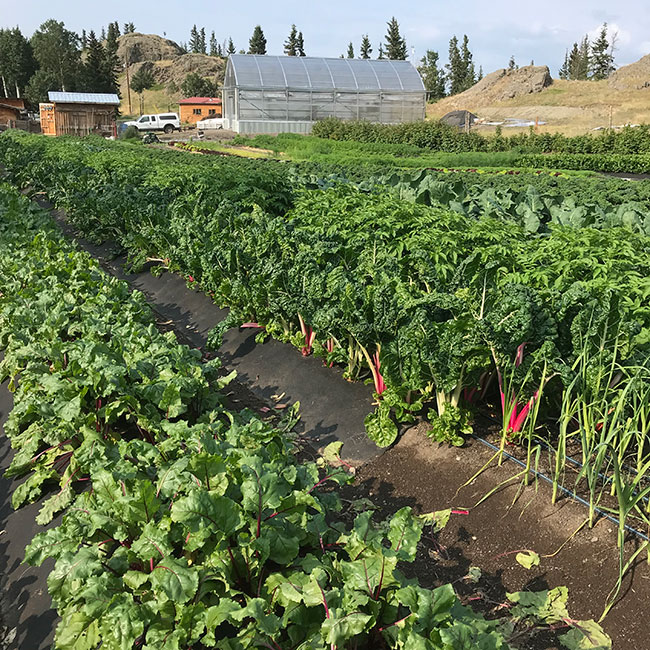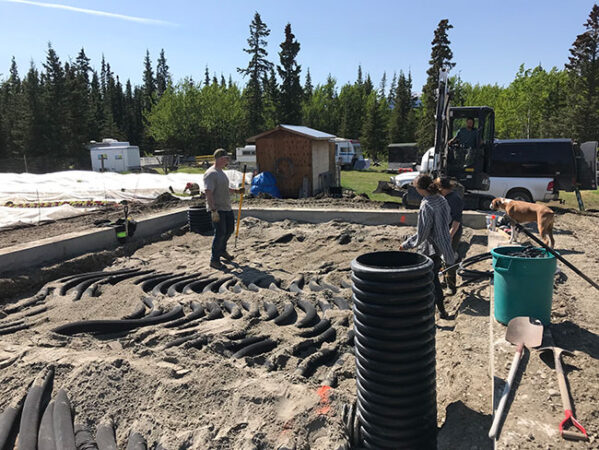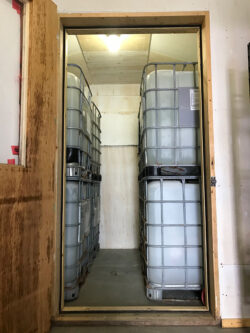
Features
Production
Profiles
It comes with the Territory
How one farmer takes advantage of Yukon’s cold weather and endless sun to grow vegetables.
December 13, 2023 By Stephanie Gordon
 Ouellette’s farm and new greenhouse in July, one of the most productive months when farming in the Yukon because of the longer days and endless sunlight.
Ouellette’s farm and new greenhouse in July, one of the most productive months when farming in the Yukon because of the longer days and endless sunlight. When a dust devil hit Sarah Ouellette’s market garden, members of her farm team found themselves paddling a canoe in the middle of the lake to fetch displaced row covers.
The two large row covers – about 45 feet by 100 feet each – were held down by heavy gravel bags. Two pieces became five when the covers were picked up like pieces of paper by the ferocious winds, clearing large rocks to end up in trees and the lake.
Many farmers in the Yukon have stories like these. In any given season, you can be at the mercy of frost, harsh weather or even grizzly bears.
A common misconception about farming in the Yukon is that it’s a vast barren wasteland where nothing grows, but that is simply not true. According to Statistic Canada’s 2021 Census of Agriculture, most farms in the Yukon are horse farms, but crop farms (23 per cent), poultry and egg farms (12 per cent) and greenhouses (10 per cent) still exist.
Highly productive out of necessity
Ouellette has been running a certified organic market garden, Sarah’s Harvest, for the last decade. The farm is on Lake Laberge, 50 kilometres north of Whitehorse. She farms only 0.4 acres, but it’s highly productive – she grew over 20,000 lbs. of produce last year. In 2019, she was named Yukon’s 2019 Farmer of the Year.
Ouellette moved to the Yukon in 2012 after interning at an organic farm in Guelph, Ont., but is “here for life” and plans to continue farming up north.
“I was skeptical if I would be able to [farm] up here, but I took a chance and started a market garden and I’ve been doing it ever since,” Ouellette says.
She farms a variety of herbs and vegetables, including lettuces, spinach, arugula, kale, Swiss chard, carrots, beets, rutabaga, fennel, kohlrabi, cabbage and potatoes. She sells directly to the community in addition to supplying retailers and restaurants.
Yukon farms look different from the large acreages found elsewhere and they thrive in their own ways. Direct sales were up by 48 per cent from 2015 and the high rate of direct sales reflects the community’s engagement in agriculture activities.
“The customer feedback is really uplifting and motivating. Our days are long and we work hard, and with the cutworm challenges and climate issues, sometimes I think it’s incredible we keep trying, but it’s really important work,” Ouellette says.

The team covers the climate battery with sand.
A cold desert
The growing conditions in the Yukon are like a cold desert. Thankfully, Ouellette’s farm is located near Lake Laberge, so essential irrigation is nearby.
“We set up irrigation before putting a single seed in the ground. I would never sow seeds before I know the irrigation system is working,” Ouellette explains.
Over the years, the soil has become extremely fertile because of a consistent effort from past owners and Ouellette to add compost to the ground.
Pests of all sizes
Frigid winters don’t mean Yukon farms are impervious to pests. Ouellette shares that cutworms have devastated her carrots and they’ve experienced Sclerotinia rot, leaf miner and root maggots in other crops.
While she’s heard stories of neighbours being visited by deer or grizzly bears, the largest pest she’s had to deal with have been voles; she thanks her livestock guardian dogs for keeping it that way.
Harvesting sunlight
In the “land of the midnight sun,” the growing season is concentrated during the summer months of June and July, when the days are long and sunlight is endless.
In the summer, the northern hemisphere is tilted toward the sun so days are long and sunny, with some northern remote areas seeing almost 24 hours of sunlight on certain days. In the winter, the northern hemisphere tilts away from the sun, shortening the days and cloaking the Yukon in darkness for up to 19 hours. It makes for a short and intense growing season.
By September, frost is frequent, and the ground is frozen by the first week of October at the latest. It’s no surprise that season extenders like greenhouses are increasing in the territories. In the last few years, greenhouses in the Yukon and neighbouring Northwest Territories increased by 54.8 per cent, and Ouellette’s operation is no different.
Ouellette is expanding by building a new 24-foot by 48-foot passive solar greenhouse to extend her season and grow seedlings for sale.
The project is grant-funded and driven by Ouellette’s desire to replace an older greenhouse that has been extremely labour-intensive. The older greenhouse also had a passive solar design, but it was all manual: with a big barrel wood stove, insulating tarps that you pull down at night and up in the morning, and all the ventilation done by hand.
“I feel like I can’t even leave the farm because the [old] greenhouse requires so much maintenance, so this new greenhouse project is going to be a real game changer,” Ouellette says.
The new passive solar greenhouse includes a climate battery, which is essentially a system of pipes in the floor with a fan in an intake pipe. When the greenhouse warms up, hot air is pumped underground to warm the soil. As the greenhouse cools down, the fan draws the heat out of the floor and back into the greenhouse. The climate battery is the first step in both cooling and heating the greenhouse, instead of venting hot air outside or using artificial heat provided by a pellet stove. Even if artificial heat was needed, Ouellette prefers a pellet stove because it allows her to use biomass instead of fossil fuels and is less labour-intensive than needing to start and monitor a fire.
The greenhouse also has an insulated north wall and insulating curtains to minimize heat loss. The greatest challenge in managing a northern greenhouse is the cold nights, especially in the spring and fall. “By storing and retaining solar heat, we can minimize the amount of artificial heat that’s needed,” Ouellette explains.
The ice house

The ice house is a well-insulated building where eight 1,000-litre tanks are filled with water that turns into ice during the winter, and is used in the summer to chill vegetables.
While the greenhouse makes use of the abundant sunlight during the summer months, Ouellette also manages to take advantage of Yukon’s infamous winters.
“Sustainable, passive technologies are really important to us,” Ouellette says.
The farm has a walk-in cooler called the “ice house” that they use to chill vegetables without the use of electricity, other than for a few LED lights.
The ice house is a well-insulated building where eight 1,000-litre tanks are filled with water during the wintertime. The building is left open during the coldest months, allowing the water to freeze and create eight tons of ice. In February, when warmer temperatures are around the corner, the insulated building is closed to preserve the ice.
“You have to be pretty creative and resourceful. There isn’t everything you need available in the city or at the store,” Ouellette explains.
The ice in the ice house is used to chill the vegetables all summer long and is able to cool vegetables to three to four degrees within a matter of hours.
“That’s one thing we can use: our cold winters. In cold climates, you can take advantage of it.”
Yukon advantage
While farming in the Yukon isn’t easy, the resilient and resourceful make do to provide an essential service to northerners, who return the favour by passionately supporting Yukon-grown produce.
At the weekly farmers’ market in Whitehorse, it’s not uncommon for the Sarah’s Harvest booth to be packed with people.
“There’s so much room for the agriculture community to grow up here,” Ouellette says. “For me I just want to fill this need for the community and the appreciation I receive from customers goes a long way in keeping us motivated.”
Print this page